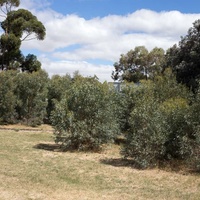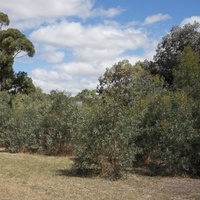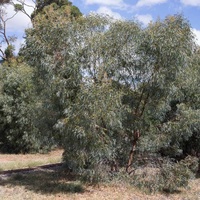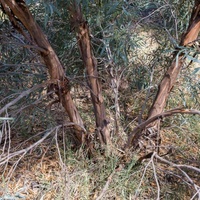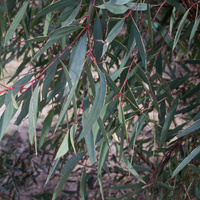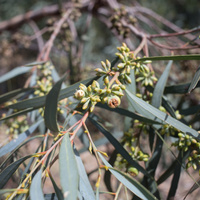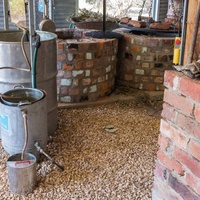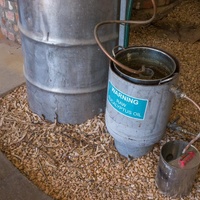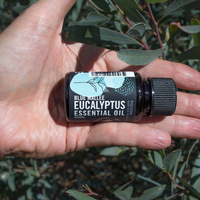Common name: Blue Mallee
Other common names: Mallee
Description
Blue Mallee is an essential oil-yielding eucalypt originating from inland regions of southern Australia, its natural range extending across semi-arid parts of neighbouring north-west Victoria and south-west New South Wales.
It is typically a multi-trunked tree 5 to 10 m (16 to 32 ft) tall, with the trunks anchored by a large root mass and leaning away from the centre, forming a wide-spreading canopy. The bark is grey-brown and peeling off in long, thin strips that accumulate at the tree's base, leaving behind smooth new bark.
The leaves are typically eucalypt, being sword-shaped, 5 to 8 cm (2 to 3 in) long and dull blue- to grey-green. They are alternately arranged along the stems at the ends of the branches and give off a characteristic eucalyptus oil aroma when crushed.
Flowers are small, with numerous creamy-white filaments set in a cup-shaped base. They are bore in small clusters of between seven and ten, arising at the sides of the branchlets, and come into bloom from early autumn to early winter.
Fertilised flowers develop into small, woody, goblet-shaped seed capsules containing small oval, grey, brown or black seed.
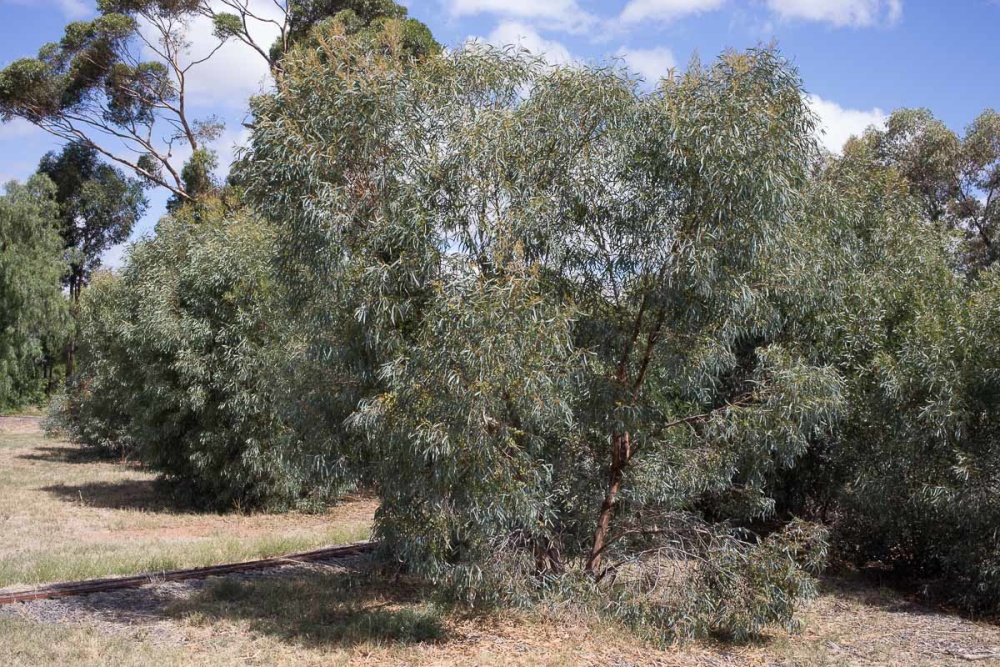
Inglewood, Victoria, Australia
Use
Blue Mallee is one of the world's principal sources of Eucalyptus oil, along with Tasmanian Blue gum (Eucalyptus globulus), Broad-leaved peppermint (Eucalyptus dives), Narrow-leaved peppermint (Eucalyptus radiata), Queensland peppermint (Eucalyptus exserta) and Gully gum (Eucalyptus smithii).
The leaves yield commercial quantities of eucalyptus oil of the cineole (aka eucalyptol) type upon steam distillation. This type of eucalyptus oil is the most valuable because of its medicinal and antiseptic qualities.
Cineole-type eucalyptus oil is a versatile product, serving as an expectorant, antiseptic, and antibacterial agent, particularly effective against Streptococcus. Its uses span from cough drops and syrups to vaporiser fluids, ointments, liniments, gargles, and oral hygiene products like toothpaste and mouthwash. It is also a common ingredient in dentistry, particularly in solvents and sealers for tooth fillings after root canal surgery.
Cineole-type oils, including those from Blue Mallee, are not just medicinal and antiseptic. They are also effective stain removers, proven to remove grease, glue, and dried stains from both skin and clothing. Eucalyptus oils, in general, are used in a wide range of commercial products, including cleaning, mould removal, disinfecting, perfumery, pharmaceuticals, personal care, and pest insect control.
Blue Mallee eucalyptus oil is a colourless to pale yellow liquid with a firm but sweet, camphorous, and fresh-cooling aroma and is similar in taste.
In commercial operations, around 7000 to 10,000 kg of fresh leaves can be harvested per hectare per year. With an average oil content of 2%, this yields 140 to 200 kg of oil, equivalent to 125 to 178 pounds of oil per acre. The cineole content ranges from 50 to 80%.
The flowers yield sufficient nectar for honey production. Pure honey is medium amber in colour, medium density, sweet, and with a good flavour. Reasonable amounts of pollen, which benefit brooding honeybees, are also yielded.
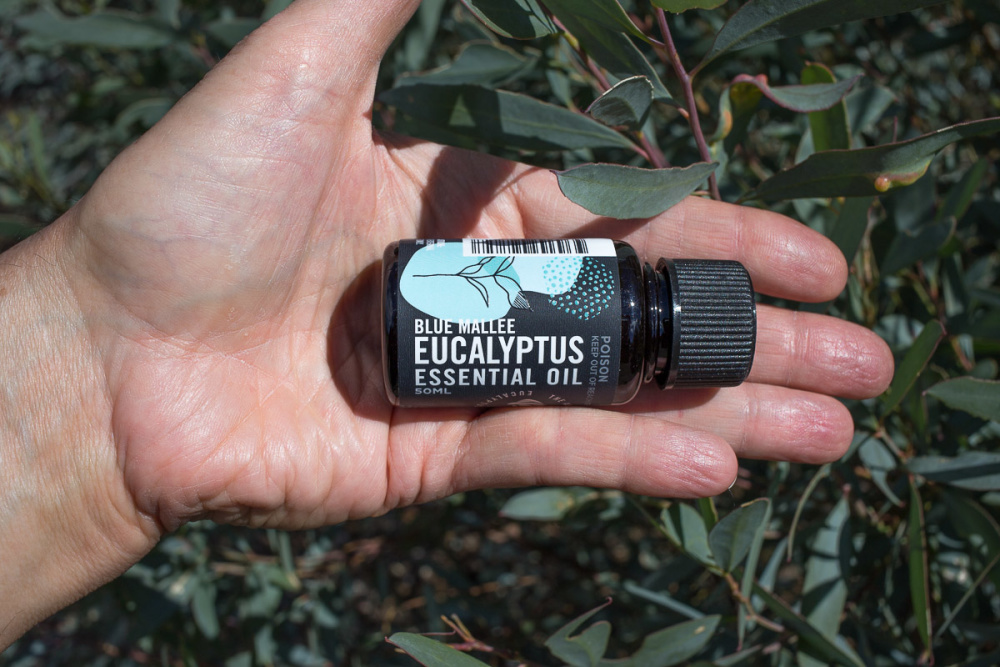
General interest
The word 'mallee' in the name 'Blue Mallee' derives from an Aboriginal term for the types of small, multi-trunked eucalyptus trees common to semi-arid regions of southern Australia.
Climate
Grows naturally in semi-arid, warm temperate climates, generally areas with annual lows of 8 to 14°C, annual highs of 21 to 25°C, annual rainfall of 400 to 600 mm and a summer dry season of 5 to 7 months, extending to 12 months with irrigation or groundwater.
Growing
Blue Mallee is not usually cultivated, and most of the material used for distilling is harvested from wild trees. This involves using a heavy roller to crush natural stands of trees to encourage new growth, which then becomes ready for harvesting in eighteen to twenty-four months.
However, there has been a recent move to establish Blue Mallee plantations. The trees are planted in rows and then mechanically harvested on an eighteen-month rotation.
Blue Mallee grows best on moderate to light, free-draining clay-loam, silt-loam, loam, sandy-loam, loamy-sand and sand soils of a moderately acid to neutral nature, generally with a pH of 5.5 to 7.5, and on sites with full-sun exposure.
Problem features
Prolonged skin contact with eucalyptus essential oil may cause burning dermatitis and blisters in some people and it can be poisonous if ingested in large amounts.
Where it grows
References
Books
-
Arctander, S. 1960, Perfume and flavor materials of natural origin, Elizabeth, New Jersey
-
Boland, D. & Brooker, I. & McDonald, M. W. 2006, Forest trees of Australia, 5th ed., CSIRO Publishing (Ensis), Melbourne
-
Brady, G. S. & Clauser, H. R & Vaccari, J. A. 2002, Materials handbook : an encyclopedia for managers, technical professionals, purchasing and production managers, technicians and supervisors, 15th ed., McGraw-Hill, New York
-
Byrne, T. & Bourke, M. & Salvin, S. 2004, The new crop industries handbook, Rural Industries Research and Development Corporation (RIRDC), Canberra, Australia
-
Cribb, A. B. & Cribb, J. W. 1982, Useful wild plants in Australia, William Collins, Sydney
-
Culbreth, D. M. R. 1927, A manual of materia medica and pharmacology : comprising the organic and inorganic drugs which are or have been recognized by the United States pharmacopeia, 7th ed., Febiger, Philadelphia
-
F. R. Beuhne 1922, Honey flora of Victoria, Melbourne Albert J. Mullett, Govt. printer
-
Guenther, E. & Althausen, D. 1948 to 1952, The essential oils (6 volumes), Van Nostrand Publishing, New York
-
Hall, N. 1972, The use of trees and shrubs in the dry country of Australia, Australian Government Publishing Service, Canberra, Australian Capital Territory
-
Khan, I. A. & Abourashed, E. A. 2010, Leung's encyclopedia of common natural ingredients : used in food, drugs and cosmetics, 3rd edition, Wiley Publishing, Hoboken, New Jersey
-
Marcar, N. E. 1995, Trees for saltland : a guide to selecting native species for Australia, Division of Forestry, Commonwealth Scientific and Industrial Research Organisation (CSIRO) Australia, Canberra
-
McIlroy, R.J. 1963, An introduction to tropical cash crops, Ibadan University Press, Ibadan, Nigeria
